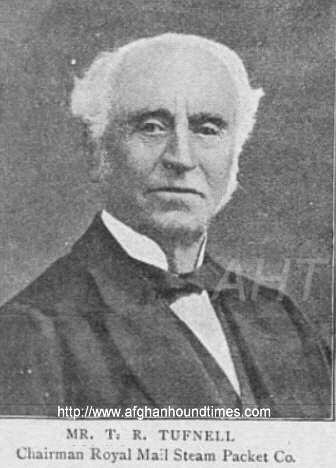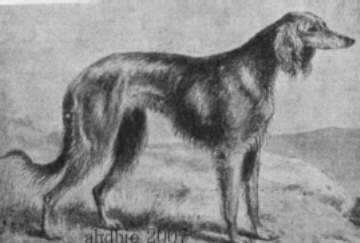(Afghan Hound Database and Breed Information Exchange)
Afghan Hound Pioneer (By Steve Tillotson January 2018)
THOMAS ROBERT TUFNELL Thomas Robert Tufnell was one of the earliest recorded importers of dogs from Afghanistan. He bred two of his imported dogs together (Roostam and Motee) and in December 1883 they produced Rajah II, making Tufnell the most likely first breeder of Afghan hounds in the United Kingdom. Tufnell was a successful businessman, starting his career by working in a bank in Bath, Somerset, England that his father co-owned. He progressed to what we would today call ‘a property magnate’. He became the chairman of the Peninsular and Oriental Steam Navigation Company (forerunner of the P&O shipping line); Deputy-Chairman of the Royal Mail Steam Packet Company; Chairman of West Flanders Railway; Director of Marine and General Assurance Company; Secretary of the Shipwrecked Fisherman's Benevolent Society, and was also associated with the laying of the first deep sea cable between Dover, England and Calais, France in the 1850s, TUFNELL'S HOUNDS Thomas Robert Tufnell worked closely with Mr Walter Kelsey Taunton (1845-1927). Taunton was another pioneering Afghan hound owner and breeder and imported ‘Khelat’ from Afghanistan. It was claimed that Khelat looked nothing like an Afghan hound and was more like an Afghan sheepdog. The famous dog writer Clifford L ‘Doggie’ Hubbard wrote that Mr Taunton also had genuine Afghan hounds and that he showed a nice bitch at Bristol, England in 1886. A newspaper report from the show confirms that Motee (an Afghan hound bitch imported by Tufnell and later owned by Taunton) was exhibited that day. Motee was also exhibited at the Crystal Palace Show, in London, England in July 1885. A year earlier than the Bristol show and the show report for the Crystal Place Show lists Tufnell as the owner. So, show reports for 1885 and 1886 confirm that Motee’s ownership moved from Tufnell (1885) to Taunton (1886).
With Tufnell having bred from Motee in 1883 (when she produced Rajah II) helps confirm the likelihood that Tufnell was her importer, first owner and first breeder of Afghan hounds in England. W K Taunton owned many exotic and foreign breeds of dogs, collected from all over the World. He was a dog dealer and had a network of contacts (such as Mr Tufnell) to whom he on-sold the dogs. Taunton was Chairman of the British Kennel Association at this time, so his influence and networks were almost certainly very large. Roostam too, imported by Tufnell, was also transferred to and exhibited by Taunton. Presuming Rajah II was similar in type to his parents, then this suggests that Motee (and Roostam) were indeed close to what we would consider to be Afghan hounds.
PERSONAL LIFE Thomas Robert Tufnell was born on 2 October 1822, in Laycock Wiltshire, England, He was the son of John Tufnell and Uliana Ivanion Margaret Fowell. His father was a major in the army and also a Justice of the Peace. On 17 July 1851, he married Frances Howard Hutchinson in Exeter, Devon, England and the couple had four sons. He secondly, married Maria Jane Bond on 20 November 1862. He died, aged 75 years, on 1 April 1898 in Lausanne, Switzerland following an accident at Dijon railway station in France. The accident was attributed to the carelessness of a railway porter. The direct rail link from Dijon to Lausanne, a distance of 137 miles was the first rail link between France and Switzerland. Sadly, Tufnell died shortly after his arrival in Lausanne. He was the youngest of 11 children and began his working career in a bank in Bath, Somerset, England, His father was a partner in the bank. He went on to become a very successful and wealthy businessman. At one time he was the owner of 35 houses as well as land at St James’ Gardens in London, England. At the time of his death his estate was valued at 43,282 pounds sterling. A whopping 4,890,216 pounds today! Although his brother had a distinguished career in India, serving as a surgeon, it is likely that Tufnell’s interest and importation of hounds from the East was attributed to, or bolstered by his eldest son’s presence there. Robert Hutchinson Campbell Tufnell (1852-1908) fought in the Afghan wars and both his sons were born in India. Thomas Robert Tufnell’s youngest son became Admiral Lionel Grant Tufnell. Tufnell’s business enterprise was located at 600 Moorgate St, London. This was the address he gave when he entered his hounds at dog shows. His residence was number 18 in the same street. He had previously lived in Heston, Middlesex in West London and in 1895 was a candidate in the elections for the Member of Parliament for Heston. PENINSULAR AND ORIENTAL STEAM NAVIGATION COMPANY The Peninsular and Oriental Steam Navigation Company later became P&O which at one time was the largest shipping company in the world. In 1854, the company took over the Bombay mail service from the East India Company who for decades had blocked P&O from berthing at Bombay. P&O were granted a Royal Charter by Queen Victoria in 1840 and Letters Patent in 1937, the Company's 100th year. TUFNELL AND THE ENGLISH CHANNEL CABLE Thomas Robert Tufnell (1822-1898) was associated with the laying of the first deep sea cable between Dover, England and Calais, France. The cable was a single copper wire and was laid in 1850. The cable was called a submarine cable making reference to it being ‘below water’. It was held down to the bed of the sea by lead weights and failed during the first night, reportedly because a French fisherman had caught the cable with his anchor, thought it was seaweed and cut it free. The cable was not expected to be a permanent success and the action of the tides soon destroyed the insulating material. It was intended as a test of the possibility of laying a cable between the two nations and having proved it was possible, a second cable was laid in 1851. It wasn't a very fast link, just five to seven words per minute being possible. Related content: Early Afghan Hounds The Origins Section British Dogs, Their Points, Selection, And Show Preparation" by W. D. Drury 1903 |



